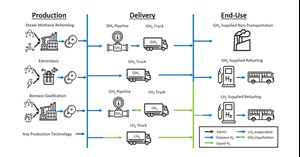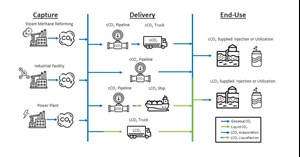News
NREL model fast-tracks H2 supply chain infrastructure deployment
The use of clean H2 and fuel cells for transportation applications—particularly for medium- and heavy-duty vehicles—is a key part of a portfolio of solutions to decarbonize U.S. transportation. Realizing the potential of clean H2 as a transportation fuel, however, will require successful widespread deployment of H2 fueling infrastructure.
Reducing the informational and financial risks associated with infrastructure investment decisions is vital to accelerate the adoption of H2 as a transportation fuel. This can be accomplished by helping stakeholders forecast H2 demand and minimize the cost of building infrastructure.
The U.S. Department of Energy's (DOE’s) National Renewable Energy Laboratory (NREL) Scenario Evaluation and Regionalization Analysis (SERA) model helps answer the question, “What is the least-cost H2 infrastructure deployment strategy over time to support demand?”
The SERA model optimizes H2 infrastructure buildout necessary to meet the growing needs of an emerging, dynamic market at a geographic and temporal level. SERA is a flexible optimization tool that allows the user to define demand, available supply locations, technologies and distribution pathways, input prices, and cost and performance parameters, which the model uses to optimize infrastructure buildout, most commonly by minimizing costs. This model is part of a comprehensive portfolio of strategic analysis activities to assess the needs, scenarios, and challenges associated with the rollout of H2 applications.

Capabilities for transportation applications and beyond. SERA has been used to design H2 supply chain infrastructure in support of both transportation and non-transportation applications, such as quantifying the cost of adoption of alternative vehicles and quantifying the number and type of H2 production technologies needed to support the growing H2 market. As such, the model can be configured to address custom scenarios and assess investment and market growth dynamics on regional and national scales over time.
One such example is the model’s role in a project to plan the implementation of H2 systems in California. The University of California, Davis leveraged SERA to model potential electrolytic H2 systems through 2050 across supply and demand sectors and achieved significant spatial detail that provided stakeholders with strategic insights.
“We recently made several upgrades to SERA, including translating the tool into the Julia programming language which has drastically increased the model’s computational efficiency, whether run on a desktop or on NREL’s high-performance computer. We’ve also added numerous capabilities to better assess a broad and diverse range of infrastructure expansion planning scenarios," said Mark Chung, group manager for Infrastructure and Energy Storage Analysis at NREL.
“SERA can be used for any fuel or commodity, including carbon dioxide—not just H2," Chung said. "For example, it can model the most cost-efficient pathways to capture and store carbon. SERA’s flexible framework to accommodate any commodity or mixture of commodities is truly unique in this sense.”
Model refinement and licensing. Funding for SERA’s development was provided by the U.S. Department of Energy’s H2 and Fuel Cell Technologies Office (HFTO) as part of a suite of tools that includes the H2 Analysis Production (H2A) model, H2A-Lite, H2 Financial Analysis Scenario Tool (H2FAST), Production Financial Analysis Scenario Tool (ProFAST), Revenue Operation and Device Optimization (RODeO) model, and Blending Pipeline Analysis Tool for H2 (BlendPATH). The portfolio has been refined for more than a decade to address strong stakeholder interest in analysis tools and models for H2 infrastructure.
SERA supports analysis activities conducted by DOE’s Regional Clean H2 Hubs Program teams; investment decisions made by DOE’s Office of Clean Energy Demonstrations. SERA also informs and validates H2 infrastructure costs across other DOE and NREL tools, such as NREL's Transportation Technology Total Cost of Ownership (T3CO) modeling framework. The tool team also actively partners with academic institutions and corporations to license the free closed-source infrastructure optimization tool.


